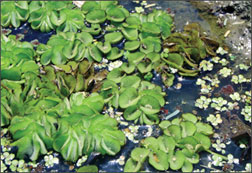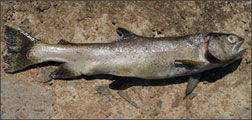An inconvenient truth
By Sajitha Prematunge
[email protected]

Salvinia

Trout Fish |
When I told one of my friends that I was writing an article about
Alien Invasive Species (AIS), she asked me if extra terrestrial plants
and animals were invading earth. Few people actually know what Alien
Invasive Species are. AIS, in this context, doesn’t have anything to do
with little green men or their plants and animals.
Alien invasive species (AIS) are non-indigenous species that has
adverse affects on the habitats they invade - economically,
environmentally or ecologically. Alien invasive species - animals as
well as plants - are a growing global concern since they can survive in
various environmental conditions and reproduce at alarming rates.
It’s interesting to note that, when it comes to plant invasive
species, countries most affected are islands like Sri Lanka. Sri Lanka
has been identified as one of the 25 bio-diversity hotspots of the
World.
With a multitude of topographical and climatic variations, it is home
to a high level of species diversity per unit area, compared to other
tropical countries. The isolation from the mainland has further
facilitated the evolution of many endemic species.
The thereat of alien invasive species may continue even after their
introduction is stopped. The existing species may multiply and colonize
the area, endangering whole ecosystems, habitats and species; could have
both ecological as well as economical repercussions.
|

Ulex |
The Director General of the National Botanical Gardens, Peradeniya
Dr. Siril Wijesundara explained to the Sunday Observer, that plants or
animals that are found in places where they do not originally belong are
referred to as ‘alien’. And any plant or animal which displaces native
species is referred to as invasive.
“Alien invasive flora competes for physical space and nutrients that
would have otherwise been totally used up by local species.” He
explained that all plant species and for that matter fauna have a
naturally built in control factor.
“But the control factor is often neglected when species are
introduced to a new environment purposely. Consequently there is nothing
to keep its growth in check.” He explained that not only alien but
native species can also demonstrate invasive traits of character.
“Even native plants, for which a control factor is absent, can behave
as an invasive species.” Alien species need not always be purposely
introduced, according to Dr. Siril Wijesundara. Some alien species are
introduced as ornamental species or accidentally find their way to a
certain location as a contaminant of another material. 59 invasive
species have so far been identified in Sri Lanka, 20 species of alien
invasive fauna and 39 species of alien invasive flora.
Alien invasive fauna species in Sri Lanka include 15 vertebrates and
five invertebrates. Out of the 59 alien invasive species 10 species of
fauna and 13 species of flora has been included in a list of the worlds
100 most dangerous AIS.
While the introduction of some species have been beneficial such as
cash crops like rubber and tea, the weeds that are considered most
threatening to native plants of Sri Lanka, are also introduced species.
As of late the major cause for the spread of alien invasive species
has been ornamental fish and horticulture trades.Many factors have come
together to speed the spread of AIS.
Starting from the lack of a control factor, efficient seed dispersal
mechanisms, rapid reproduction rate, exchange of seed material between
countries, transport or import of organic matter (compost) and soils
contaminated with seeds, agricultural machinery contaminated with seeds
and lack of awareness are some of the causes.
The most major invasive plant species are Salvinia, Water Hyacinth,
Giant Mimosa, Prickly Lantana, Kattakumanjal, Mesquite and Ulex.
Mesquite and the Prickly Pear Cactus have invaded the arid zone
scrublands while the Pond Apple has invaded the coastal marshes. Water
Hyacinth was introduced by Lady Blake, wife of Governor Blake as an
ornamental plant.
Salvinia was introduced to Sri Lanka in the 1950s for scientific uses
of local universities, but have now turned in to a bothersome aquatic
weed. Attempts at destroying the weed, by way of administering herbicide
and mechanical methods had been unsuccessful because of its rapid
reproduction rate and the costs involved in the eradication methods.
In mid 1980’s another species Cyrtobagus salviniae was introduced to
Sri Lanka as a biocontrol agent to Salvinia. Although this has proved
effective for the wet zone, the application of the biocontrol had to be
administered in the wet season for the dry zone while the biocontrol
agent has failed to produce similar results for cooler climates of Sri
Lanka.
Alien invasive flora can alter the structure and function of
ecosystems in many ways. AIS can produce substances that are toxic to
native vegetation and make the soil inappropriate for indigenous
species. Invasive plants like Salvinia and Water Hyacinth that grow as
dense mats covering water surfaces, tend to accumulate huge amounts of
sediment.
This coupled with the high intensity of transpiration causes wetlands
to ultimately turn in to terrestrial habitats. Most alien invasive flora
species of Sri Lanka act as weed and cause much damage to crops,
resulting in major economic blows.
Some alien invasive plants such as Prickly Lantana (Lantana camara)
and Chromalaena odorata are known to facilitate the spread of forest
fires, causing major damage to bio-diversity.
Alien invasive species pose threat to indigenous species in many
aspects. Alien invasive fauna prey on local species of fauna and flora.
Among the invasive fish species The Rainbow Trout, Clown-knife Fish, The
Guppy, Western Mosquito Fish and Walking Catfish are predators of
indigenous species.
The AIS also act as superior competitors for food and other
resources, thereby displacing native species. Tilapias breed at an
alarming rate and often displace native species, at certain instances
highly threatened indigenous species.
The feral buffalo and cattle pose a threat to native large herbivores
such as deer, sambar and elephant by competing for limited food
resources, especially in the dry zone where the food is scares.
The wallowing in the mud by the buffaloes turns the water holes
muddy, preventing the elephant population from visiting the holes.
Another direct threat to the gene pool of indigenous species is
hybridization with indigenous species. This happens by interbreeding
with indigenous species. A good example is the hybridization occurring
from the domestic buffalo interbreeding with the native wild water
buffalo.
Some AIS are reputed agricultural pests. The ship rat and the house
mouse mainly feed on rice. The Giant African Snail and slug are other
examples. Alien invasive fauna can act as decease carrying hosts. For
instance, the ship rat functions as a host for Leptospirosis virus,
while the feral cats and dogs are hosts of the rabies virus.
But not all alien invasive species have entirely bad effects. For
example the thick Gorse in the Horton Plains provide a good habitat for
the endemic Black-lipped Lizard and several amphibians, providing them
with food and cover.
It is also a popular roosting site for birds. The fruits of
Strawberry Guava and Cactus are eaten by langurs and monkeys. And the
alien invasive shrub Eupatorium riparium in the montane region serves as
a browsing plant for Sambar. |
